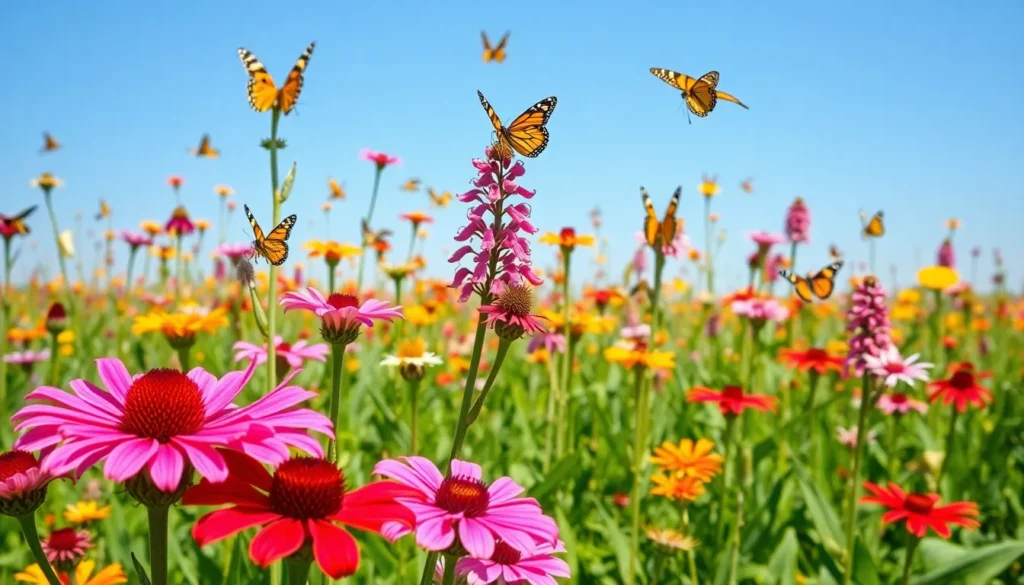When it comes to the enchanting world of hingagyi, choosing the right milkweed is like picking the perfect sidekick for a superhero. Not all milkweeds are created equal, and the right one can make all the difference in attracting those beautiful butterflies and supporting local ecosystems.
Which Milkweed For Hingagyi
Hingagyi thrives in specific habitats, favoring moist, well-drained soil. This plant often grows near rivers, wetlands, or coastal areas where water availability is ample. They require sunlight for optimal growth, typically needing full sun or partial shade to flourish.
Native to regions that experience both dry and wet seasons, hingagyi showcases adaptability. This trait allows it to survive occasional droughts while still benefitting from seasonal rains. Its roots stabilize the soil, preventing erosion and supporting surrounding plant life.
Wildlife plays a significant role in hingagyi’s ecosystem. Many pollinators, including butterflies and bees, are drawn to its blossoms. These insects directly benefit from the nectar produced by hingagyi, enhancing pollination rates in the area.
Planting milkweed varieties that complement hingagyi encourages a thriving environment. Species like Asclepias tuberosa and Asclepias incarnata are excellent options, attracting the desired pollinators. These types of milkweed not only provide nectar but also serve as host plants for various butterfly species, fostering population growth.
Understanding hingagyi’s habitat and its symbiotic relationships with local flora and fauna highlights the importance of choosing compatible milkweed. Selecting the right type maximizes ecological benefits and supports a vibrant ecosystem for both hingagyi and its butterfly visitors.
Importance of Milkweed in Hingagyi Development

Milkweed plays a critical role in the healthy development of hingagyi. Selecting the right milkweed types enhances ecological balance and supports local butterfly populations.
Role of Milkweed in Ecosystems
Milkweed serves as a vital component in many ecosystems. This plant provides nectar that attracts various pollinators, including butterflies and bees. Pollinators contribute to plant reproduction, promoting biodiversity. Diverse pollinator populations rely on milkweed for nourishment during their life cycles. Plants like Asclepias tuberosa and Asclepias incarnata not only feed pollinators but also offer breeding grounds. These interactions help create a rich ecosystem that benefits many species, including hingagyi.
Interaction Between Hingagyi and Milkweed
Hingagyi interacts synergistically with milkweed to create a thriving environment. As hingagyi grows, it supports milkweed diversity by providing shaded areas and stable soil structures. These interactions enhance both plants’ resilience against environmental stressors. Moreover, hingagyi attracts pollinators that rely on milkweed for food and habitat. The relationship between these plants fosters a balanced ecosystem, promoting nutrient cycling and habitat stability. Consequently, ensuring the availability of compatible milkweed types is essential to maximizing the ecological benefits in the hingagyi’s habitat.
Types of Milkweed Suitable for Hingagyi
Choosing the right milkweed varieties significantly impacts hingagyi’s growth and ecosystem support. Various types flourish in this context.
Common Milkweed Varieties
Asclepias tuberosa, known as butterfly weed, thrives in sunny areas and attracts a range of pollinators. This type contains vibrant orange flowers that appeal to butterflies. Asclepias incarnata, or swamp milkweed, prefers moist soil, making it suitable for riverbanks and wetlands. It features clusters of pink flowers that also draw beneficial insects. Another noteworthy variety is Asclepias syriaca, often called common milkweed, which is adaptable to different soil types and environments. Its large flower clusters offer an abundant nectar source, bolstering local pollinator populations.
Native vs. Non-Native Milkweed
Native milkweed varieties play a crucial role in the ecosystem, providing food and habitat for local monarch butterflies and other pollinators. They generally adapt better to local soil and climate conditions. Non-native milkweed, while still able to attract pollinators, may not support the entire lifecycle of certain species. This can lead to a decline in local butterfly populations. Prioritizing native milkweed types enhances ecological interactions by fostering a stable environment that supports both hingagyi and its surrounding biodiversity.
Factors to Consider When Choosing Milkweed
Selecting the right milkweed requires careful consideration of specific factors. Understanding these factors can significantly enhance the ecological roles of hingagyi.
Climate and Soil Conditions
Climate and soil conditions play a pivotal role in milkweed selection. Local climate influences which milkweed thrives best. Asclepias tuberosa flourishes in well-drained soil under full sun, whereas Asclepias incarnata prefers moist, rich soils and partial shade. Soil type also determines growth; sandy soils favor some varieties while clay soils support others. Matching milkweed species to local soil types ensures optimal growth conditions. Proper acclimatization to local climates enhances resilience against pests and diseases. Any choice made should consider moisture levels typical for the hingagyi region.
Availability and Sustainability
Availability and sustainability of milkweed varieties prove essential. Sourcing native species like Asclepias tuberosa or Asclepias syriaca supports local pollinator populations. Local nurseries often carry native milkweed, making them accessible for planting. Sustainable practices involve collecting seeds responsibly from local populations. Selecting organic or pesticide-free plants minimizes harm to pollinators. Availability not only encourages biodiversity but also strengthens ecosystem stability. Recognizing the importance of sustainable sourcing ensures long-term benefits for hingagyi and surrounding flora.
Tips for Cultivating Milkweed for Hingagyi
Cultivating milkweed for hingagyi focuses on optimizing growth and supporting pollinators. Following best practices ensures healthy plants and thriving ecosystems.
Best Practices for Planting
Ensure proper timing by planting milkweed in early spring or fall. Select a spot with full sun or partial shade to mimic its natural habitat. Use well-drained soil to promote healthy root development. Space plants at least 18 inches apart to allow air circulation, reducing the risk of disease. Incorporate organic compost at planting to enrich soil nutrients. Choose native varieties like Asclepias tuberosa or Asclepias incarnata for better adaptability. These species naturally attract local pollinators, enhancing community biodiversity.
Maintenance and Care
Water the plants regularly during dry spells, especially in their establishment phase. Apply mulch around the base to retain soil moisture and suppress weeds. Monitor for pests, such as aphids, and remove them by hand or with water sprays. Prune any dead or unhealthy stems to improve air circulation and promote growth. Fertilizing isn’t necessary but can be beneficial in nutrient-poor soils. Rely on organic fertilizers to support sustainable practices. Attract additional pollinators by planting companion flowers nearby, creating a more vibrant ecosystem for hingagyi.
Final
Selecting the right milkweed for hingagyi is essential for fostering a healthy ecosystem. By prioritizing native varieties like Asclepias tuberosa and Asclepias incarnata, gardeners can enhance local biodiversity and attract vital pollinators. These milkweed types not only provide nourishment but also create suitable habitats for species that thrive in hingagyi’s environment.
Implementing sustainable practices when planting and maintaining milkweed will ensure long-term benefits for both hingagyi and the surrounding flora. By understanding the unique needs of each milkweed species and their interactions with hingagyi, individuals can contribute to a thriving ecosystem that supports a variety of wildlife.

